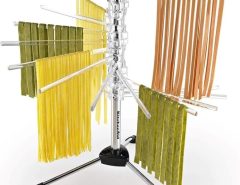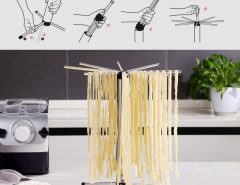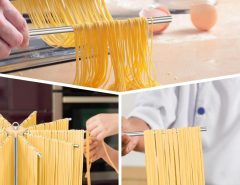That satisfying sound of rolling fresh pasta dough can quickly turn into an annoying symphony of squeaks and grinding noises when your pasta maker starts showing its age. If your once-smooth pasta machine now sounds like a rusty gate, don’t panic – this comprehensive guide will walk you through safely lubricating squeaking pasta maker to restore its whisper-quiet operation and extend its lifespan.
Understanding Why Your Pasta Maker Squeaks
Before diving into lubrication techniques, it’s essential to understand what causes pasta makers to develop those irritating squeaks. The primary culprit is usually dried pasta dough residue that accumulates in the machine’s moving parts over time. This buildup creates friction between metal components, leading to squeaking sounds and potentially damaging your equipment.
Other common causes include:
- Lack of proper maintenance and cleaning
- Metal-on-metal contact without adequate lubrication
- Worn-out components that need replacement
- Moisture exposure causing rust or corrosion
- Overuse without regular maintenance intervals

Safety First: Food-Safe Lubrication Guidelines
When lubricating kitchen equipment that comes into contact with food, safety must be your top priority. Never use standard household lubricants, automotive oils, or industrial lubricants on your pasta maker, as these products contain chemicals that can contaminate your food and pose serious health risks.
FDA-Approved Food-Safe Lubricants
The safest approach is using FDA-approved food-grade lubricants specifically designed for kitchen equipment. These products are formulated to be safe for incidental food contact and won’t compromise the taste or safety of your homemade pasta.
Popular food-safe options include:
- Food-grade mineral oil
- White petroleum jelly (food-grade)
- Specialized kitchen equipment lubricants
- Silicone-based food-safe sprays
Natural Alternatives for Pasta Maker Maintenance
If you prefer natural solutions, several household items can serve as temporary lubricants:
Coconut Oil: Virgin coconut oil works well as a natural lubricant and is completely food-safe. Apply sparingly to moving parts, but remember that coconut oil can solidify at cooler temperatures.
Olive Oil: While not ideal for long-term lubrication, high-quality olive oil can provide temporary relief from squeaking. Use extra virgin olive oil and apply minimally to avoid attracting dust and debris.
Vegetable Shortening: Solid vegetable shortening can be effective for lubricating gear mechanisms, though it may require more frequent reapplication than specialized lubricants.
Step-by-Step Lubrication Process
Preparation and Cleaning
Before applying any lubricant, thoroughly clean your pasta maker to remove dried dough, flour residue, and any accumulated debris. Use a dry brush or cloth to clean accessible areas, and avoid using water on the internal mechanisms unless your manufacturer specifically recommends it.
Identifying Lubrication Points
Most pasta makers have several key areas that require attention:
Rolling Mechanisms: The main rollers and their adjustment screws often need lubrication to maintain smooth operation.
Gear Systems: Internal gears that control the roller spacing and cutting mechanisms require periodic lubrication.
Pivot Points: Any hinges or rotating connections should be checked for squeaking and lubricated as needed.
Cutting Attachments: If your pasta maker includes cutting attachments, these moving parts may also need attention.
Application Technique
Apply lubricant sparingly using a clean cloth or cotton swab. Focus on metal-to-metal contact points where friction occurs. Work the mechanism by hand several times to distribute the lubricant evenly throughout the moving parts.
Avoid over-lubrication, which can attract flour and dough particles, creating a paste-like substance that actually increases friction and squeaking over time.
Maintenance Schedule and Best Practices
Regular Cleaning Routine
Establish a consistent cleaning routine after each use. Remove any dough residue immediately while it’s still soft, as dried pasta dough becomes much harder to remove and can damage your machine’s components.
Monthly Deep Cleaning
Once a month, perform a thorough cleaning and inspection of your pasta maker. Check for signs of wear, accumulated debris, or areas that might benefit from lubrication.
Seasonal Lubrication
Depending on usage frequency, most pasta makers benefit from lubrication every 3-6 months. Heavy users may need to lubricate more frequently, while occasional users might extend this interval.
Troubleshooting Common Issues
Persistent Squeaking After Lubrication
If squeaking continues after proper lubrication, the issue might be more serious. Check for:
- Worn or damaged components that need replacement
- Improper assembly after cleaning
- Excessive wear requiring professional repair
Sticky or Gummy Mechanisms
Over-lubrication or using the wrong type of lubricant can cause mechanisms to become sticky. Clean thoroughly and reapply lubricant sparingly.
Rust or Corrosion
If you discover rust on your pasta maker, address it immediately. Light surface rust can often be removed with fine steel wool, followed by proper lubrication to prevent recurrence.
Professional Maintenance Considerations
While most pasta maker maintenance can be handled at home, some situations require professional attention. Consider professional service if you encounter:
- Severe rust or corrosion
- Broken or severely worn components
- Electrical issues with motorized models
- Persistent problems despite proper maintenance
Extending Your Pasta Maker’s Lifespan
Proper lubrication is just one aspect of pasta maker maintenance. Additional steps to extend your machine’s lifespan include:
Proper Storage: Store your pasta maker in a dry environment to prevent moisture-related issues.
Gentle Operation: Avoid forcing the machine or using excessive pressure when rolling dough.
Quality Ingredients: Use proper pasta flour and avoid overly wet or sticky doughs that can clog mechanisms.
Regular Inspection: Check for loose screws, worn components, or other issues before they become major problems.
Frequently Asked Questions
Q: How often should I lubricate my pasta maker? A: Most home pasta makers need lubrication every 3-6 months, depending on usage frequency. Heavy users may need monthly lubrication.
Q: Can I use cooking oil to lubricate my pasta maker? A: While cooking oils can provide temporary lubrication, they’re not ideal for long-term use as they can become rancid and attract debris. Food-grade mineral oil is a better choice.
Q: Is it safe to disassemble my pasta maker for cleaning? A: Only disassemble components that are designed to be removable. Consult your owner’s manual and avoid forcing parts that seem permanently attached.
Q: What should I do if my pasta maker is still squeaking after lubrication? A: Persistent squeaking may indicate worn components or improper lubrication. Check for damaged parts and consider professional repair if issues continue.
Q: Can I use WD-40 on my pasta maker? A: No, never use WD-40 or similar products on kitchen equipment. These contain chemicals that are unsafe for food contact.
Read More Also: How to Clean and Maintain Your Pasta Maker Properly
Take Action for Better Pasta Making
Don’t let a squeaking pasta maker compromise your homemade pasta experience. Start by identifying the source of the noise, then follow this guide to safely lubricate your machine using food-safe products. Remember that regular maintenance not only eliminates annoying squeaks but also extends your pasta maker’s lifespan and ensures consistently excellent results.
Ready to restore your pasta maker to its original smooth operation? Gather your food-safe lubricant and cleaning supplies, and dedicate 30 minutes to proper maintenance. Your pasta maker – and your taste buds – will thank you for the attention. Share your maintenance success stories in the comments below, and don’t forget to bookmark this guide for future reference when your pasta maker needs its next tune-up.





Leave a Reply